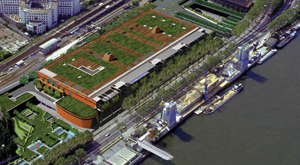Half of Paris, including the famous Louvre museum, is heated by a network including three district energy plants powered by municipal waste: St Ouen, Issy-les-Moulineaux, and Ivry-Paris XIII. The plants combust non-recyclable household waste from some 3.6 million Parisian households, generating electricity and selling it to Electricité de France (EDF) to supply the electricity grid, selling the steam to the Compagnie Parisienne de Chauffage Urbain (CPCU) the Parisian company for district heating, to supply heating and hot water to some 300,000 households, offices, hospitals and other buildings, including the Louvre.

The Saint-Ouen EFW plant, in operation since 1990, treats some 600,000 tonnes of household waste. In order to reduce the amount of road traffic, bottom ashes are transported from the plant by boat along the river Seine.
The Ivry-Paris XIII EFW plant, built in 1969, has been regularly modernized over the years and currently has a treatment capacity of 700,000 tonnes of household waste per year.
The Issy-les Moulineaux (ISSEANE) EFW plant treats 460,000 tonnes of residual waste a year. The ISSEANE plant generates 200 tonnes/hour of steam, at 50 bars pressure and 400 degrees C, and an electrical capacity of 50 MW. It is widely known for its innovative design, as it has been built partially underground and the chimney has been designed in such a way that no large stack is visible on the Paris skyline.
The three plants are owned by SYCTOM, the waste treatment authority, which represents the western suburbs of Paris and neighbouring towns.
